Narrative Review of Obesity Prevalence Causes in Ethnic Indians
VerifiedAdded on 2023/06/08
|62
|17793
|366
Literature Review
AI Summary
This narrative review investigates the causes of obesity prevalence in ethnic Indian populations, addressing the growing public health concern and associated co-morbidities. The review highlights the ethnic diversity within India and regional differences in obesity statistics, considering genetic, environmental, and socio-cultural factors. It examines dietary habits, physical activity levels, socioeconomic status, and the influence of mass media on obesity trends. The review also identifies gaps in previous research, such as the need for gender and ethnicity-specific data, and explores potential strategies for obesity prevention in ethnic Indian communities. This document is available on Desklib, where students can find similar solved assignments and resources.
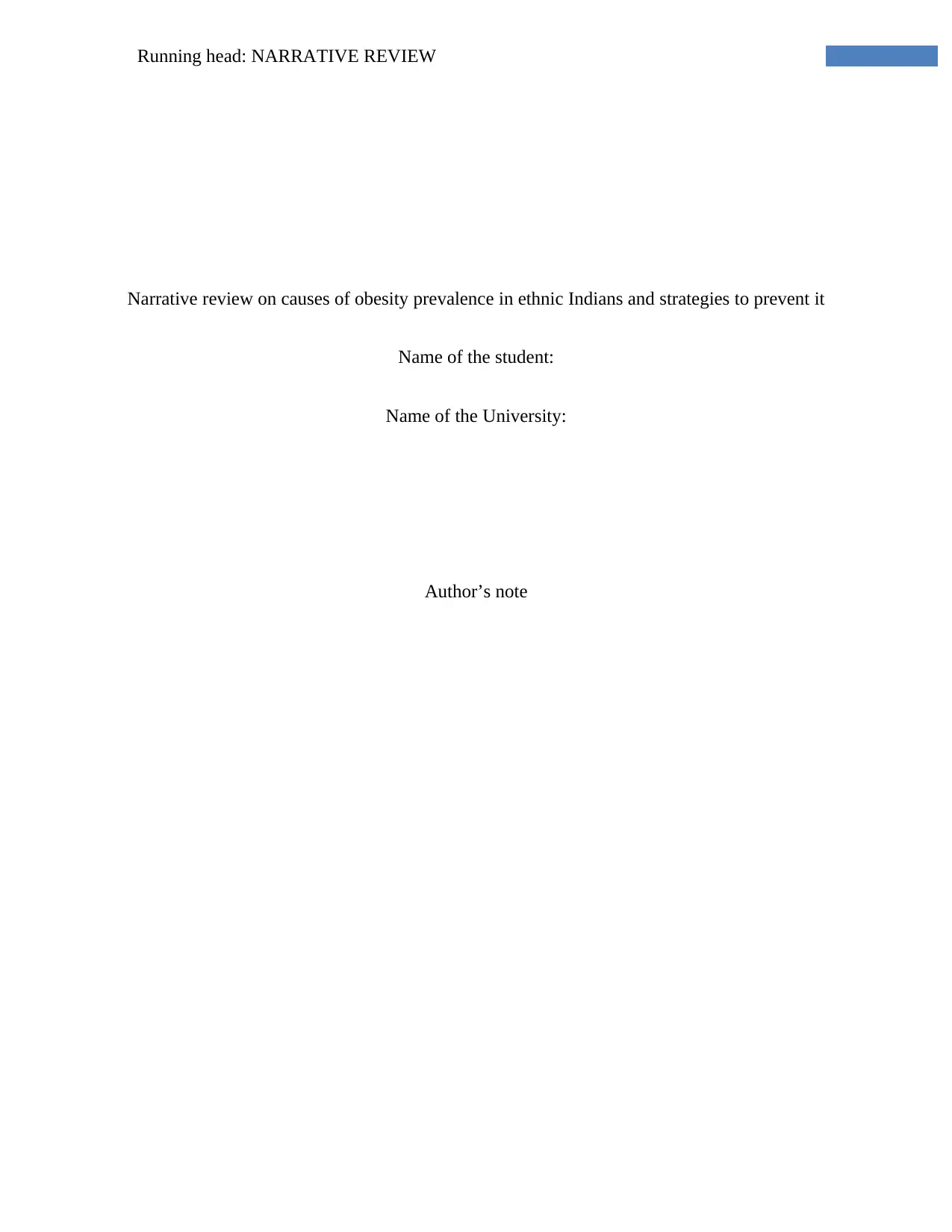
Running head: NARRATIVE REVIEW
Narrative review on causes of obesity prevalence in ethnic Indians and strategies to prevent it
Name of the student:
Name of the University:
Author’s note
Narrative review on causes of obesity prevalence in ethnic Indians and strategies to prevent it
Name of the student:
Name of the University:
Author’s note
Paraphrase This Document
Need a fresh take? Get an instant paraphrase of this document with our AI Paraphraser
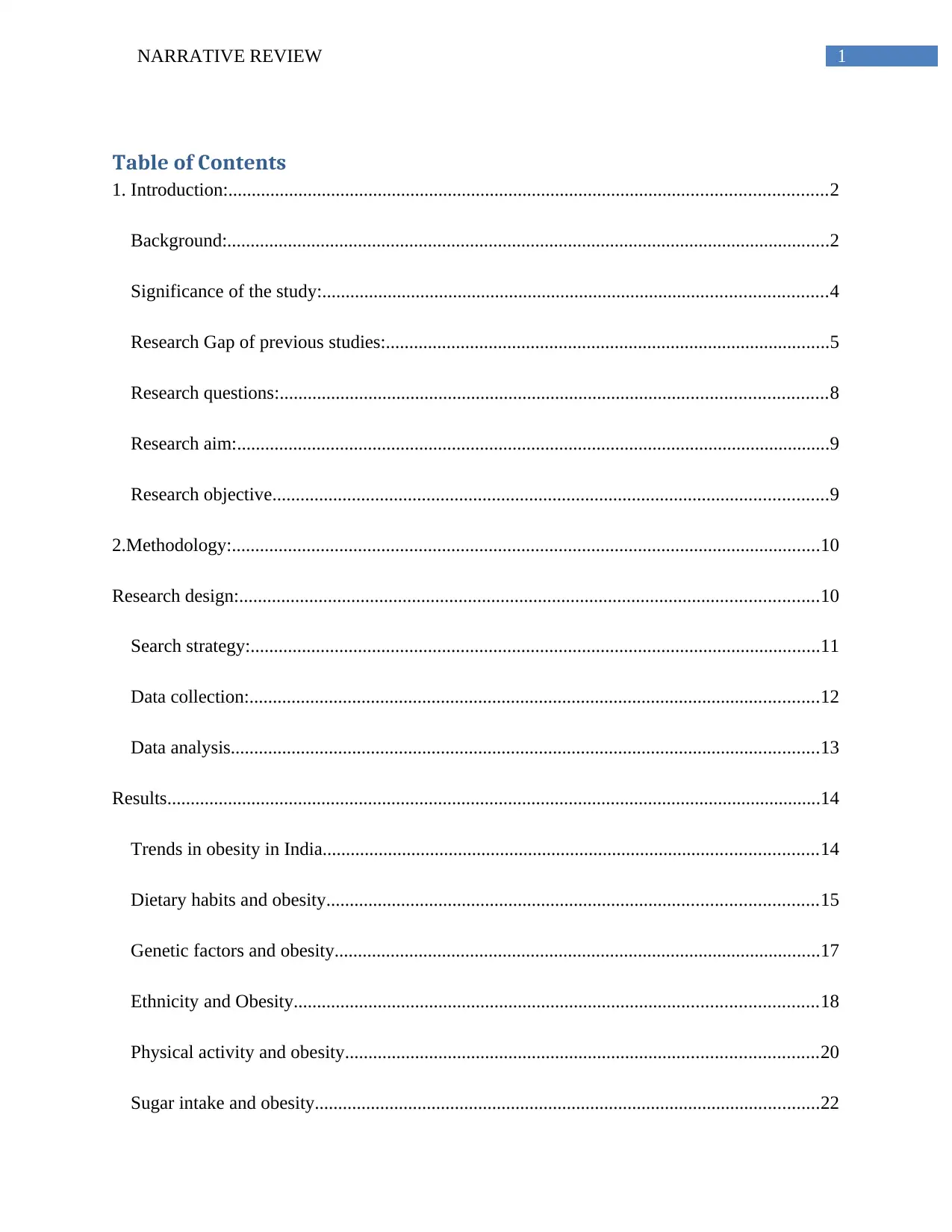
1NARRATIVE REVIEW
Table of Contents
1. Introduction:................................................................................................................................2
Background:.................................................................................................................................2
Significance of the study:............................................................................................................4
Research Gap of previous studies:...............................................................................................5
Research questions:.....................................................................................................................8
Research aim:...............................................................................................................................9
Research objective.......................................................................................................................9
2.Methodology:..............................................................................................................................10
Research design:............................................................................................................................10
Search strategy:..........................................................................................................................11
Data collection:..........................................................................................................................12
Data analysis..............................................................................................................................13
Results............................................................................................................................................14
Trends in obesity in India..........................................................................................................14
Dietary habits and obesity.........................................................................................................15
Genetic factors and obesity........................................................................................................17
Ethnicity and Obesity................................................................................................................18
Physical activity and obesity.....................................................................................................20
Sugar intake and obesity............................................................................................................22
Table of Contents
1. Introduction:................................................................................................................................2
Background:.................................................................................................................................2
Significance of the study:............................................................................................................4
Research Gap of previous studies:...............................................................................................5
Research questions:.....................................................................................................................8
Research aim:...............................................................................................................................9
Research objective.......................................................................................................................9
2.Methodology:..............................................................................................................................10
Research design:............................................................................................................................10
Search strategy:..........................................................................................................................11
Data collection:..........................................................................................................................12
Data analysis..............................................................................................................................13
Results............................................................................................................................................14
Trends in obesity in India..........................................................................................................14
Dietary habits and obesity.........................................................................................................15
Genetic factors and obesity........................................................................................................17
Ethnicity and Obesity................................................................................................................18
Physical activity and obesity.....................................................................................................20
Sugar intake and obesity............................................................................................................22
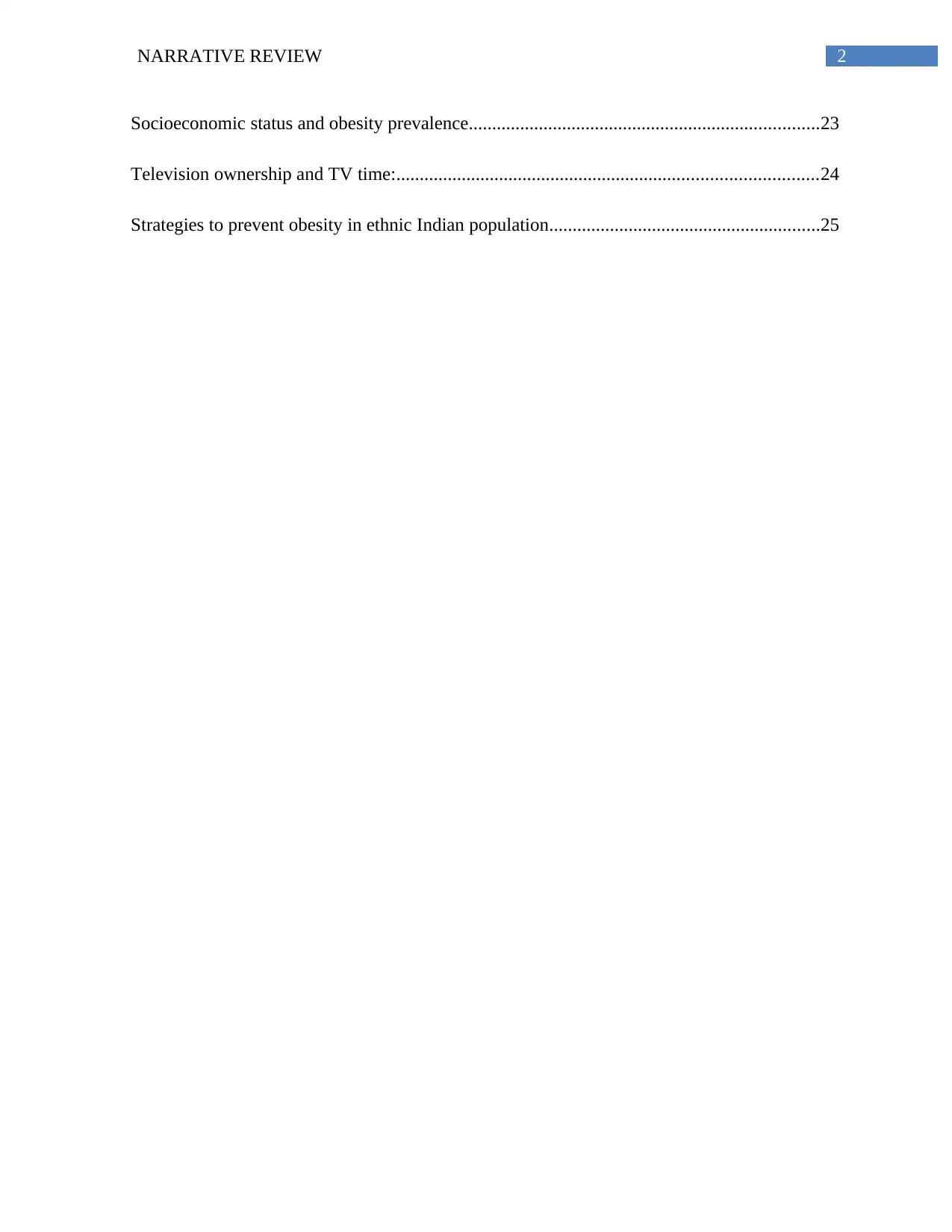
2NARRATIVE REVIEW
Socioeconomic status and obesity prevalence...........................................................................23
Television ownership and TV time:..........................................................................................24
Strategies to prevent obesity in ethnic Indian population..........................................................25
Socioeconomic status and obesity prevalence...........................................................................23
Television ownership and TV time:..........................................................................................24
Strategies to prevent obesity in ethnic Indian population..........................................................25
⊘ This is a preview!⊘
Do you want full access?
Subscribe today to unlock all pages.

Trusted by 1+ million students worldwide
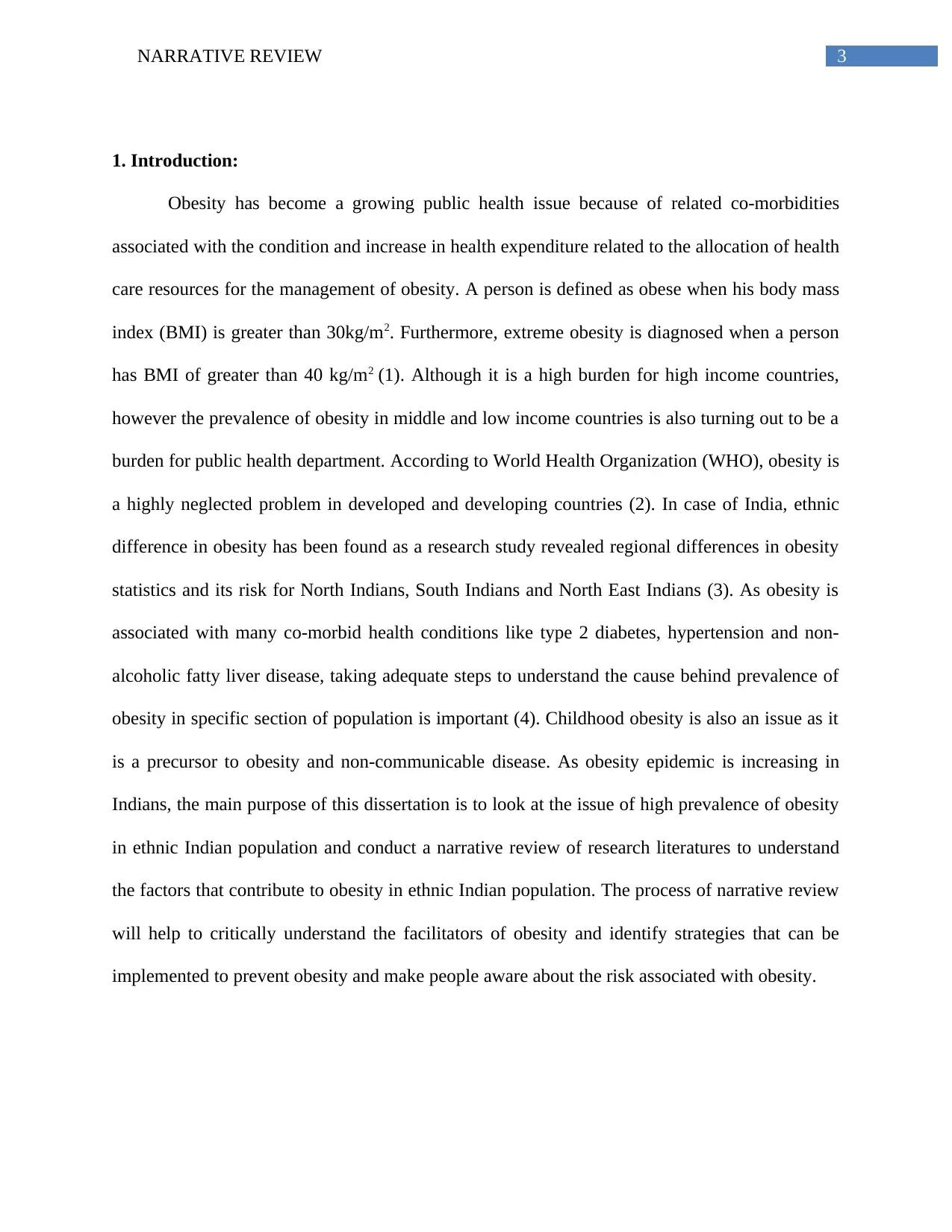
3NARRATIVE REVIEW
1. Introduction:
Obesity has become a growing public health issue because of related co-morbidities
associated with the condition and increase in health expenditure related to the allocation of health
care resources for the management of obesity. A person is defined as obese when his body mass
index (BMI) is greater than 30kg/m2. Furthermore, extreme obesity is diagnosed when a person
has BMI of greater than 40 kg/m2 (1). Although it is a high burden for high income countries,
however the prevalence of obesity in middle and low income countries is also turning out to be a
burden for public health department. According to World Health Organization (WHO), obesity is
a highly neglected problem in developed and developing countries (2). In case of India, ethnic
difference in obesity has been found as a research study revealed regional differences in obesity
statistics and its risk for North Indians, South Indians and North East Indians (3). As obesity is
associated with many co-morbid health conditions like type 2 diabetes, hypertension and non-
alcoholic fatty liver disease, taking adequate steps to understand the cause behind prevalence of
obesity in specific section of population is important (4). Childhood obesity is also an issue as it
is a precursor to obesity and non-communicable disease. As obesity epidemic is increasing in
Indians, the main purpose of this dissertation is to look at the issue of high prevalence of obesity
in ethnic Indian population and conduct a narrative review of research literatures to understand
the factors that contribute to obesity in ethnic Indian population. The process of narrative review
will help to critically understand the facilitators of obesity and identify strategies that can be
implemented to prevent obesity and make people aware about the risk associated with obesity.
1. Introduction:
Obesity has become a growing public health issue because of related co-morbidities
associated with the condition and increase in health expenditure related to the allocation of health
care resources for the management of obesity. A person is defined as obese when his body mass
index (BMI) is greater than 30kg/m2. Furthermore, extreme obesity is diagnosed when a person
has BMI of greater than 40 kg/m2 (1). Although it is a high burden for high income countries,
however the prevalence of obesity in middle and low income countries is also turning out to be a
burden for public health department. According to World Health Organization (WHO), obesity is
a highly neglected problem in developed and developing countries (2). In case of India, ethnic
difference in obesity has been found as a research study revealed regional differences in obesity
statistics and its risk for North Indians, South Indians and North East Indians (3). As obesity is
associated with many co-morbid health conditions like type 2 diabetes, hypertension and non-
alcoholic fatty liver disease, taking adequate steps to understand the cause behind prevalence of
obesity in specific section of population is important (4). Childhood obesity is also an issue as it
is a precursor to obesity and non-communicable disease. As obesity epidemic is increasing in
Indians, the main purpose of this dissertation is to look at the issue of high prevalence of obesity
in ethnic Indian population and conduct a narrative review of research literatures to understand
the factors that contribute to obesity in ethnic Indian population. The process of narrative review
will help to critically understand the facilitators of obesity and identify strategies that can be
implemented to prevent obesity and make people aware about the risk associated with obesity.
Paraphrase This Document
Need a fresh take? Get an instant paraphrase of this document with our AI Paraphraser
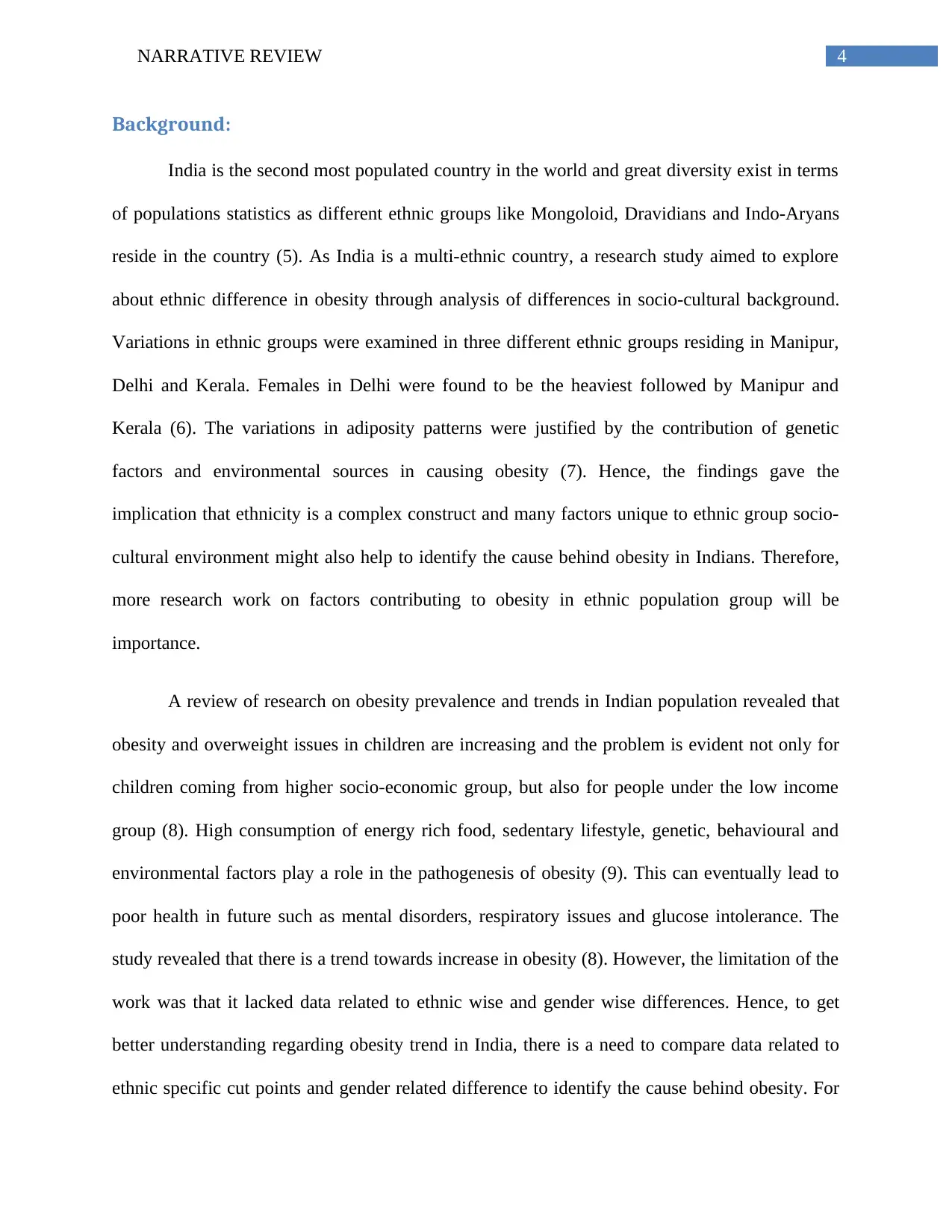
4NARRATIVE REVIEW
Background:
India is the second most populated country in the world and great diversity exist in terms
of populations statistics as different ethnic groups like Mongoloid, Dravidians and Indo-Aryans
reside in the country (5). As India is a multi-ethnic country, a research study aimed to explore
about ethnic difference in obesity through analysis of differences in socio-cultural background.
Variations in ethnic groups were examined in three different ethnic groups residing in Manipur,
Delhi and Kerala. Females in Delhi were found to be the heaviest followed by Manipur and
Kerala (6). The variations in adiposity patterns were justified by the contribution of genetic
factors and environmental sources in causing obesity (7). Hence, the findings gave the
implication that ethnicity is a complex construct and many factors unique to ethnic group socio-
cultural environment might also help to identify the cause behind obesity in Indians. Therefore,
more research work on factors contributing to obesity in ethnic population group will be
importance.
A review of research on obesity prevalence and trends in Indian population revealed that
obesity and overweight issues in children are increasing and the problem is evident not only for
children coming from higher socio-economic group, but also for people under the low income
group (8). High consumption of energy rich food, sedentary lifestyle, genetic, behavioural and
environmental factors play a role in the pathogenesis of obesity (9). This can eventually lead to
poor health in future such as mental disorders, respiratory issues and glucose intolerance. The
study revealed that there is a trend towards increase in obesity (8). However, the limitation of the
work was that it lacked data related to ethnic wise and gender wise differences. Hence, to get
better understanding regarding obesity trend in India, there is a need to compare data related to
ethnic specific cut points and gender related difference to identify the cause behind obesity. For
Background:
India is the second most populated country in the world and great diversity exist in terms
of populations statistics as different ethnic groups like Mongoloid, Dravidians and Indo-Aryans
reside in the country (5). As India is a multi-ethnic country, a research study aimed to explore
about ethnic difference in obesity through analysis of differences in socio-cultural background.
Variations in ethnic groups were examined in three different ethnic groups residing in Manipur,
Delhi and Kerala. Females in Delhi were found to be the heaviest followed by Manipur and
Kerala (6). The variations in adiposity patterns were justified by the contribution of genetic
factors and environmental sources in causing obesity (7). Hence, the findings gave the
implication that ethnicity is a complex construct and many factors unique to ethnic group socio-
cultural environment might also help to identify the cause behind obesity in Indians. Therefore,
more research work on factors contributing to obesity in ethnic population group will be
importance.
A review of research on obesity prevalence and trends in Indian population revealed that
obesity and overweight issues in children are increasing and the problem is evident not only for
children coming from higher socio-economic group, but also for people under the low income
group (8). High consumption of energy rich food, sedentary lifestyle, genetic, behavioural and
environmental factors play a role in the pathogenesis of obesity (9). This can eventually lead to
poor health in future such as mental disorders, respiratory issues and glucose intolerance. The
study revealed that there is a trend towards increase in obesity (8). However, the limitation of the
work was that it lacked data related to ethnic wise and gender wise differences. Hence, to get
better understanding regarding obesity trend in India, there is a need to compare data related to
ethnic specific cut points and gender related difference to identify the cause behind obesity. For
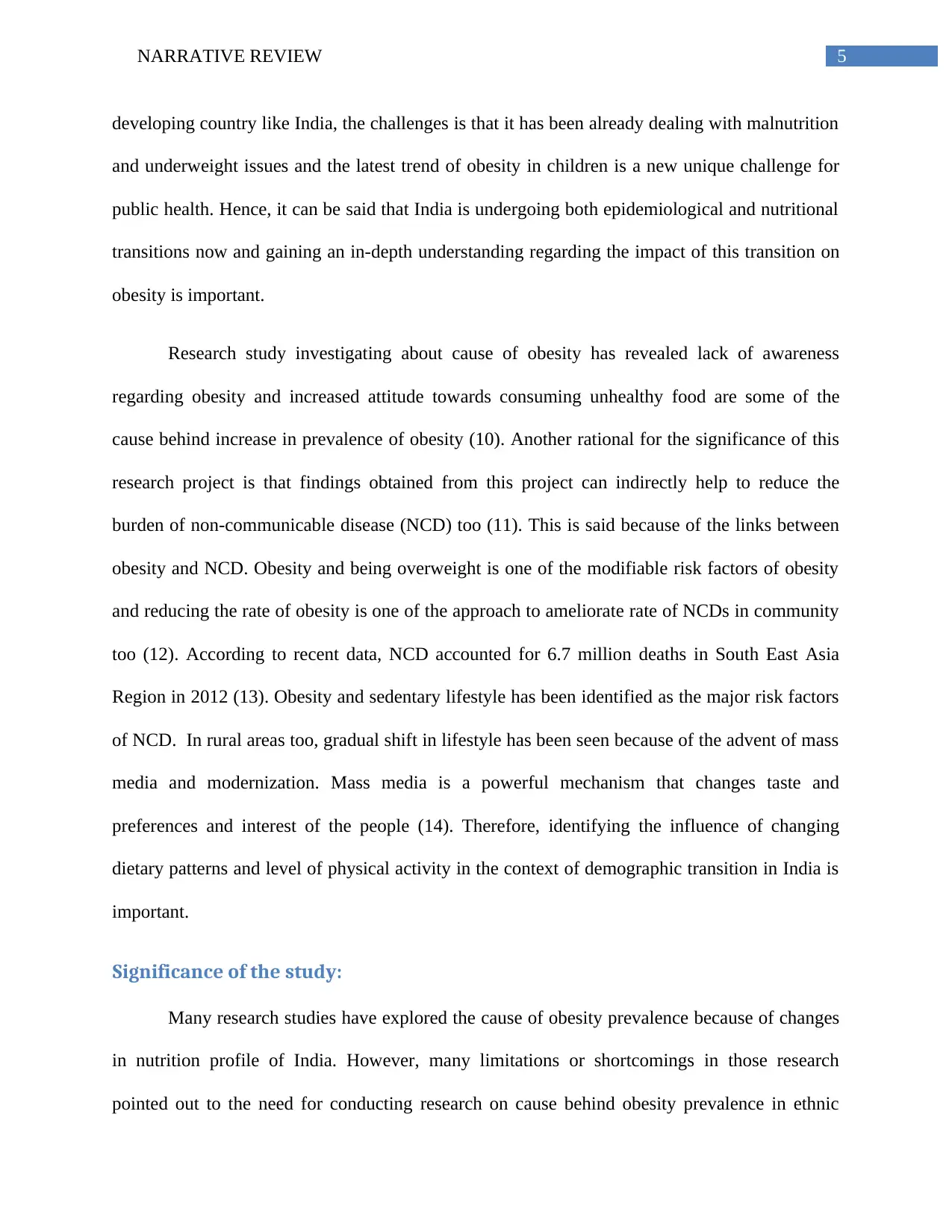
5NARRATIVE REVIEW
developing country like India, the challenges is that it has been already dealing with malnutrition
and underweight issues and the latest trend of obesity in children is a new unique challenge for
public health. Hence, it can be said that India is undergoing both epidemiological and nutritional
transitions now and gaining an in-depth understanding regarding the impact of this transition on
obesity is important.
Research study investigating about cause of obesity has revealed lack of awareness
regarding obesity and increased attitude towards consuming unhealthy food are some of the
cause behind increase in prevalence of obesity (10). Another rational for the significance of this
research project is that findings obtained from this project can indirectly help to reduce the
burden of non-communicable disease (NCD) too (11). This is said because of the links between
obesity and NCD. Obesity and being overweight is one of the modifiable risk factors of obesity
and reducing the rate of obesity is one of the approach to ameliorate rate of NCDs in community
too (12). According to recent data, NCD accounted for 6.7 million deaths in South East Asia
Region in 2012 (13). Obesity and sedentary lifestyle has been identified as the major risk factors
of NCD. In rural areas too, gradual shift in lifestyle has been seen because of the advent of mass
media and modernization. Mass media is a powerful mechanism that changes taste and
preferences and interest of the people (14). Therefore, identifying the influence of changing
dietary patterns and level of physical activity in the context of demographic transition in India is
important.
Significance of the study:
Many research studies have explored the cause of obesity prevalence because of changes
in nutrition profile of India. However, many limitations or shortcomings in those research
pointed out to the need for conducting research on cause behind obesity prevalence in ethnic
developing country like India, the challenges is that it has been already dealing with malnutrition
and underweight issues and the latest trend of obesity in children is a new unique challenge for
public health. Hence, it can be said that India is undergoing both epidemiological and nutritional
transitions now and gaining an in-depth understanding regarding the impact of this transition on
obesity is important.
Research study investigating about cause of obesity has revealed lack of awareness
regarding obesity and increased attitude towards consuming unhealthy food are some of the
cause behind increase in prevalence of obesity (10). Another rational for the significance of this
research project is that findings obtained from this project can indirectly help to reduce the
burden of non-communicable disease (NCD) too (11). This is said because of the links between
obesity and NCD. Obesity and being overweight is one of the modifiable risk factors of obesity
and reducing the rate of obesity is one of the approach to ameliorate rate of NCDs in community
too (12). According to recent data, NCD accounted for 6.7 million deaths in South East Asia
Region in 2012 (13). Obesity and sedentary lifestyle has been identified as the major risk factors
of NCD. In rural areas too, gradual shift in lifestyle has been seen because of the advent of mass
media and modernization. Mass media is a powerful mechanism that changes taste and
preferences and interest of the people (14). Therefore, identifying the influence of changing
dietary patterns and level of physical activity in the context of demographic transition in India is
important.
Significance of the study:
Many research studies have explored the cause of obesity prevalence because of changes
in nutrition profile of India. However, many limitations or shortcomings in those research
pointed out to the need for conducting research on cause behind obesity prevalence in ethnic
⊘ This is a preview!⊘
Do you want full access?
Subscribe today to unlock all pages.

Trusted by 1+ million students worldwide
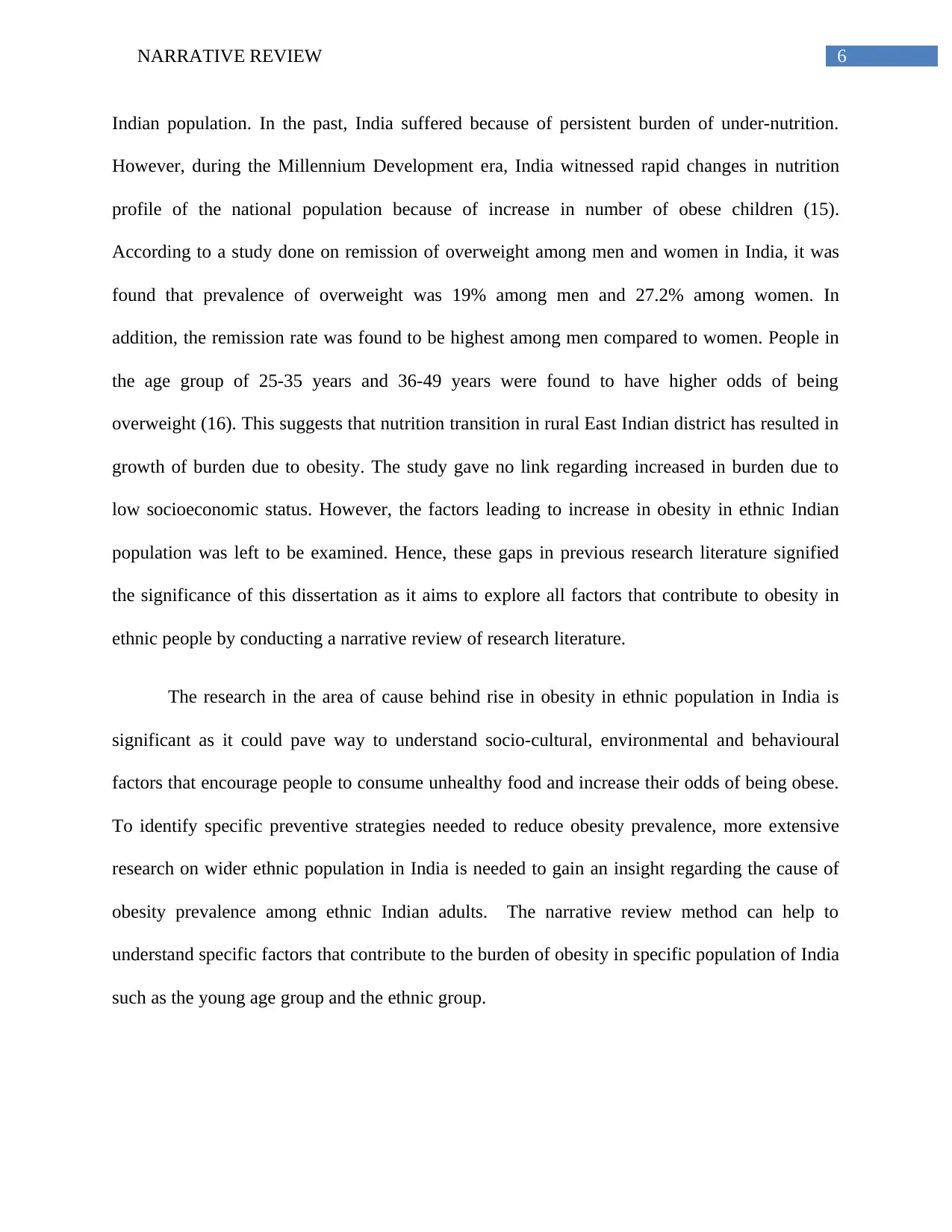
6NARRATIVE REVIEW
Indian population. In the past, India suffered because of persistent burden of under-nutrition.
However, during the Millennium Development era, India witnessed rapid changes in nutrition
profile of the national population because of increase in number of obese children (15).
According to a study done on remission of overweight among men and women in India, it was
found that prevalence of overweight was 19% among men and 27.2% among women. In
addition, the remission rate was found to be highest among men compared to women. People in
the age group of 25-35 years and 36-49 years were found to have higher odds of being
overweight (16). This suggests that nutrition transition in rural East Indian district has resulted in
growth of burden due to obesity. The study gave no link regarding increased in burden due to
low socioeconomic status. However, the factors leading to increase in obesity in ethnic Indian
population was left to be examined. Hence, these gaps in previous research literature signified
the significance of this dissertation as it aims to explore all factors that contribute to obesity in
ethnic people by conducting a narrative review of research literature.
The research in the area of cause behind rise in obesity in ethnic population in India is
significant as it could pave way to understand socio-cultural, environmental and behavioural
factors that encourage people to consume unhealthy food and increase their odds of being obese.
To identify specific preventive strategies needed to reduce obesity prevalence, more extensive
research on wider ethnic population in India is needed to gain an insight regarding the cause of
obesity prevalence among ethnic Indian adults. The narrative review method can help to
understand specific factors that contribute to the burden of obesity in specific population of India
such as the young age group and the ethnic group.
Indian population. In the past, India suffered because of persistent burden of under-nutrition.
However, during the Millennium Development era, India witnessed rapid changes in nutrition
profile of the national population because of increase in number of obese children (15).
According to a study done on remission of overweight among men and women in India, it was
found that prevalence of overweight was 19% among men and 27.2% among women. In
addition, the remission rate was found to be highest among men compared to women. People in
the age group of 25-35 years and 36-49 years were found to have higher odds of being
overweight (16). This suggests that nutrition transition in rural East Indian district has resulted in
growth of burden due to obesity. The study gave no link regarding increased in burden due to
low socioeconomic status. However, the factors leading to increase in obesity in ethnic Indian
population was left to be examined. Hence, these gaps in previous research literature signified
the significance of this dissertation as it aims to explore all factors that contribute to obesity in
ethnic people by conducting a narrative review of research literature.
The research in the area of cause behind rise in obesity in ethnic population in India is
significant as it could pave way to understand socio-cultural, environmental and behavioural
factors that encourage people to consume unhealthy food and increase their odds of being obese.
To identify specific preventive strategies needed to reduce obesity prevalence, more extensive
research on wider ethnic population in India is needed to gain an insight regarding the cause of
obesity prevalence among ethnic Indian adults. The narrative review method can help to
understand specific factors that contribute to the burden of obesity in specific population of India
such as the young age group and the ethnic group.
Paraphrase This Document
Need a fresh take? Get an instant paraphrase of this document with our AI Paraphraser
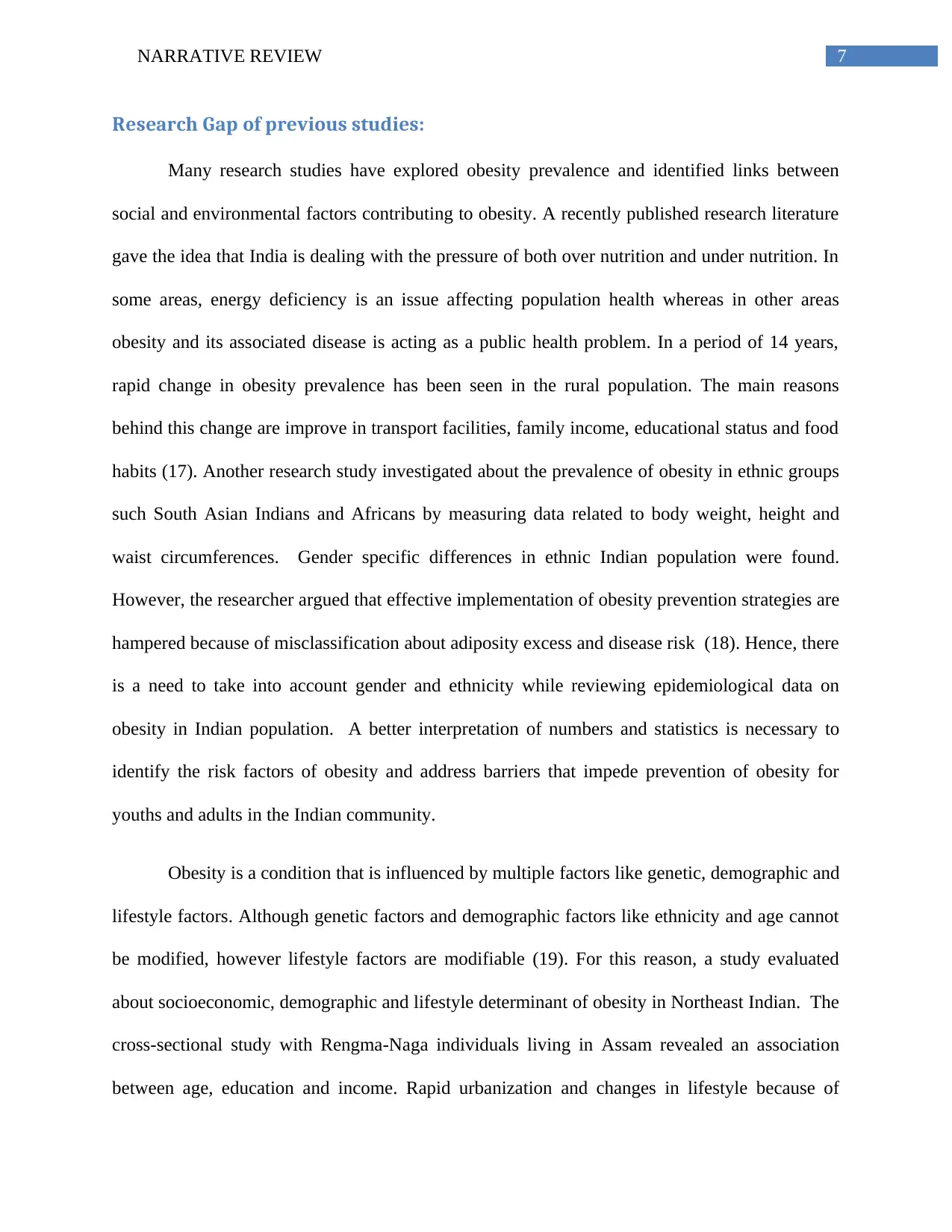
7NARRATIVE REVIEW
Research Gap of previous studies:
Many research studies have explored obesity prevalence and identified links between
social and environmental factors contributing to obesity. A recently published research literature
gave the idea that India is dealing with the pressure of both over nutrition and under nutrition. In
some areas, energy deficiency is an issue affecting population health whereas in other areas
obesity and its associated disease is acting as a public health problem. In a period of 14 years,
rapid change in obesity prevalence has been seen in the rural population. The main reasons
behind this change are improve in transport facilities, family income, educational status and food
habits (17). Another research study investigated about the prevalence of obesity in ethnic groups
such South Asian Indians and Africans by measuring data related to body weight, height and
waist circumferences. Gender specific differences in ethnic Indian population were found.
However, the researcher argued that effective implementation of obesity prevention strategies are
hampered because of misclassification about adiposity excess and disease risk (18). Hence, there
is a need to take into account gender and ethnicity while reviewing epidemiological data on
obesity in Indian population. A better interpretation of numbers and statistics is necessary to
identify the risk factors of obesity and address barriers that impede prevention of obesity for
youths and adults in the Indian community.
Obesity is a condition that is influenced by multiple factors like genetic, demographic and
lifestyle factors. Although genetic factors and demographic factors like ethnicity and age cannot
be modified, however lifestyle factors are modifiable (19). For this reason, a study evaluated
about socioeconomic, demographic and lifestyle determinant of obesity in Northeast Indian. The
cross-sectional study with Rengma-Naga individuals living in Assam revealed an association
between age, education and income. Rapid urbanization and changes in lifestyle because of
Research Gap of previous studies:
Many research studies have explored obesity prevalence and identified links between
social and environmental factors contributing to obesity. A recently published research literature
gave the idea that India is dealing with the pressure of both over nutrition and under nutrition. In
some areas, energy deficiency is an issue affecting population health whereas in other areas
obesity and its associated disease is acting as a public health problem. In a period of 14 years,
rapid change in obesity prevalence has been seen in the rural population. The main reasons
behind this change are improve in transport facilities, family income, educational status and food
habits (17). Another research study investigated about the prevalence of obesity in ethnic groups
such South Asian Indians and Africans by measuring data related to body weight, height and
waist circumferences. Gender specific differences in ethnic Indian population were found.
However, the researcher argued that effective implementation of obesity prevention strategies are
hampered because of misclassification about adiposity excess and disease risk (18). Hence, there
is a need to take into account gender and ethnicity while reviewing epidemiological data on
obesity in Indian population. A better interpretation of numbers and statistics is necessary to
identify the risk factors of obesity and address barriers that impede prevention of obesity for
youths and adults in the Indian community.
Obesity is a condition that is influenced by multiple factors like genetic, demographic and
lifestyle factors. Although genetic factors and demographic factors like ethnicity and age cannot
be modified, however lifestyle factors are modifiable (19). For this reason, a study evaluated
about socioeconomic, demographic and lifestyle determinant of obesity in Northeast Indian. The
cross-sectional study with Rengma-Naga individuals living in Assam revealed an association
between age, education and income. Rapid urbanization and changes in lifestyle because of
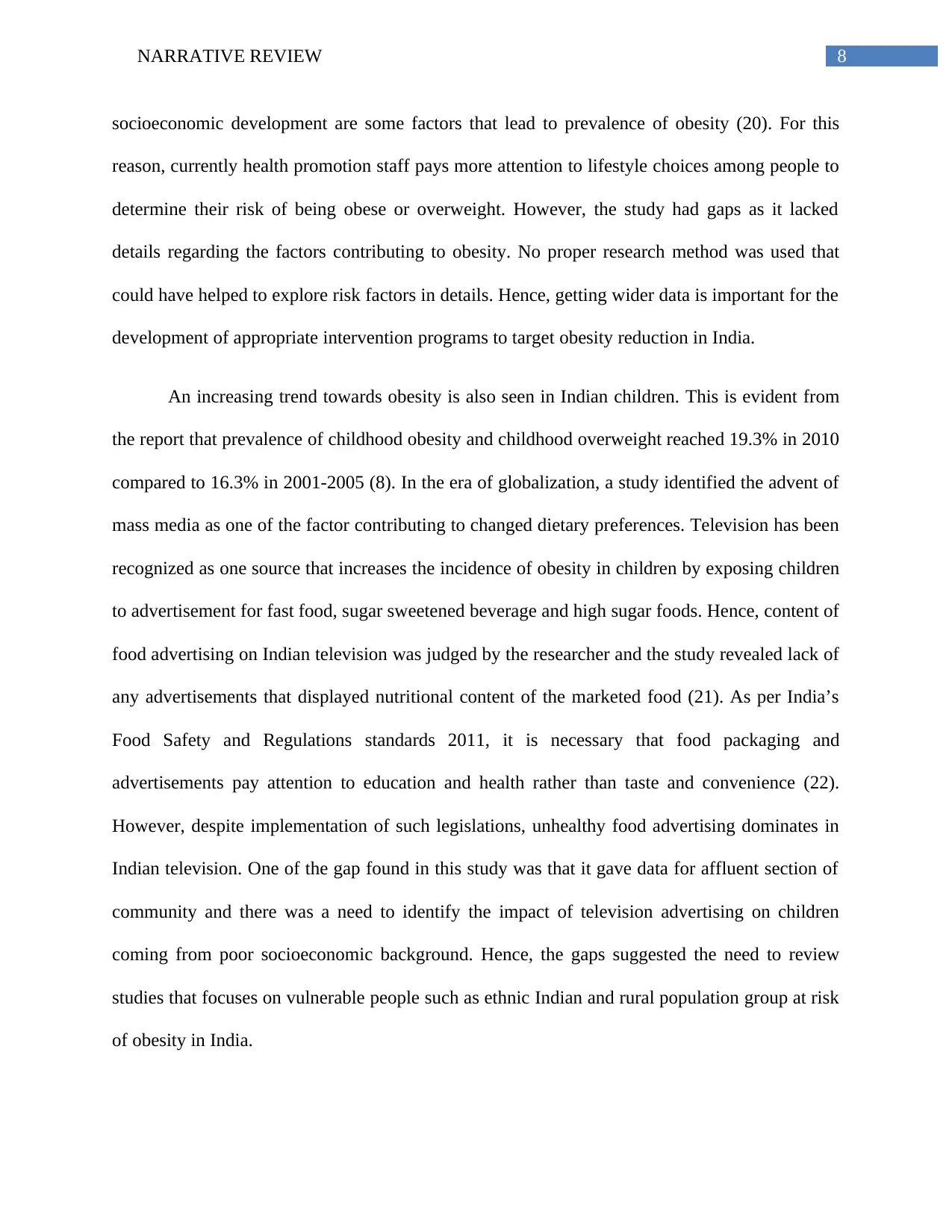
8NARRATIVE REVIEW
socioeconomic development are some factors that lead to prevalence of obesity (20). For this
reason, currently health promotion staff pays more attention to lifestyle choices among people to
determine their risk of being obese or overweight. However, the study had gaps as it lacked
details regarding the factors contributing to obesity. No proper research method was used that
could have helped to explore risk factors in details. Hence, getting wider data is important for the
development of appropriate intervention programs to target obesity reduction in India.
An increasing trend towards obesity is also seen in Indian children. This is evident from
the report that prevalence of childhood obesity and childhood overweight reached 19.3% in 2010
compared to 16.3% in 2001-2005 (8). In the era of globalization, a study identified the advent of
mass media as one of the factor contributing to changed dietary preferences. Television has been
recognized as one source that increases the incidence of obesity in children by exposing children
to advertisement for fast food, sugar sweetened beverage and high sugar foods. Hence, content of
food advertising on Indian television was judged by the researcher and the study revealed lack of
any advertisements that displayed nutritional content of the marketed food (21). As per India’s
Food Safety and Regulations standards 2011, it is necessary that food packaging and
advertisements pay attention to education and health rather than taste and convenience (22).
However, despite implementation of such legislations, unhealthy food advertising dominates in
Indian television. One of the gap found in this study was that it gave data for affluent section of
community and there was a need to identify the impact of television advertising on children
coming from poor socioeconomic background. Hence, the gaps suggested the need to review
studies that focuses on vulnerable people such as ethnic Indian and rural population group at risk
of obesity in India.
socioeconomic development are some factors that lead to prevalence of obesity (20). For this
reason, currently health promotion staff pays more attention to lifestyle choices among people to
determine their risk of being obese or overweight. However, the study had gaps as it lacked
details regarding the factors contributing to obesity. No proper research method was used that
could have helped to explore risk factors in details. Hence, getting wider data is important for the
development of appropriate intervention programs to target obesity reduction in India.
An increasing trend towards obesity is also seen in Indian children. This is evident from
the report that prevalence of childhood obesity and childhood overweight reached 19.3% in 2010
compared to 16.3% in 2001-2005 (8). In the era of globalization, a study identified the advent of
mass media as one of the factor contributing to changed dietary preferences. Television has been
recognized as one source that increases the incidence of obesity in children by exposing children
to advertisement for fast food, sugar sweetened beverage and high sugar foods. Hence, content of
food advertising on Indian television was judged by the researcher and the study revealed lack of
any advertisements that displayed nutritional content of the marketed food (21). As per India’s
Food Safety and Regulations standards 2011, it is necessary that food packaging and
advertisements pay attention to education and health rather than taste and convenience (22).
However, despite implementation of such legislations, unhealthy food advertising dominates in
Indian television. One of the gap found in this study was that it gave data for affluent section of
community and there was a need to identify the impact of television advertising on children
coming from poor socioeconomic background. Hence, the gaps suggested the need to review
studies that focuses on vulnerable people such as ethnic Indian and rural population group at risk
of obesity in India.
⊘ This is a preview!⊘
Do you want full access?
Subscribe today to unlock all pages.

Trusted by 1+ million students worldwide
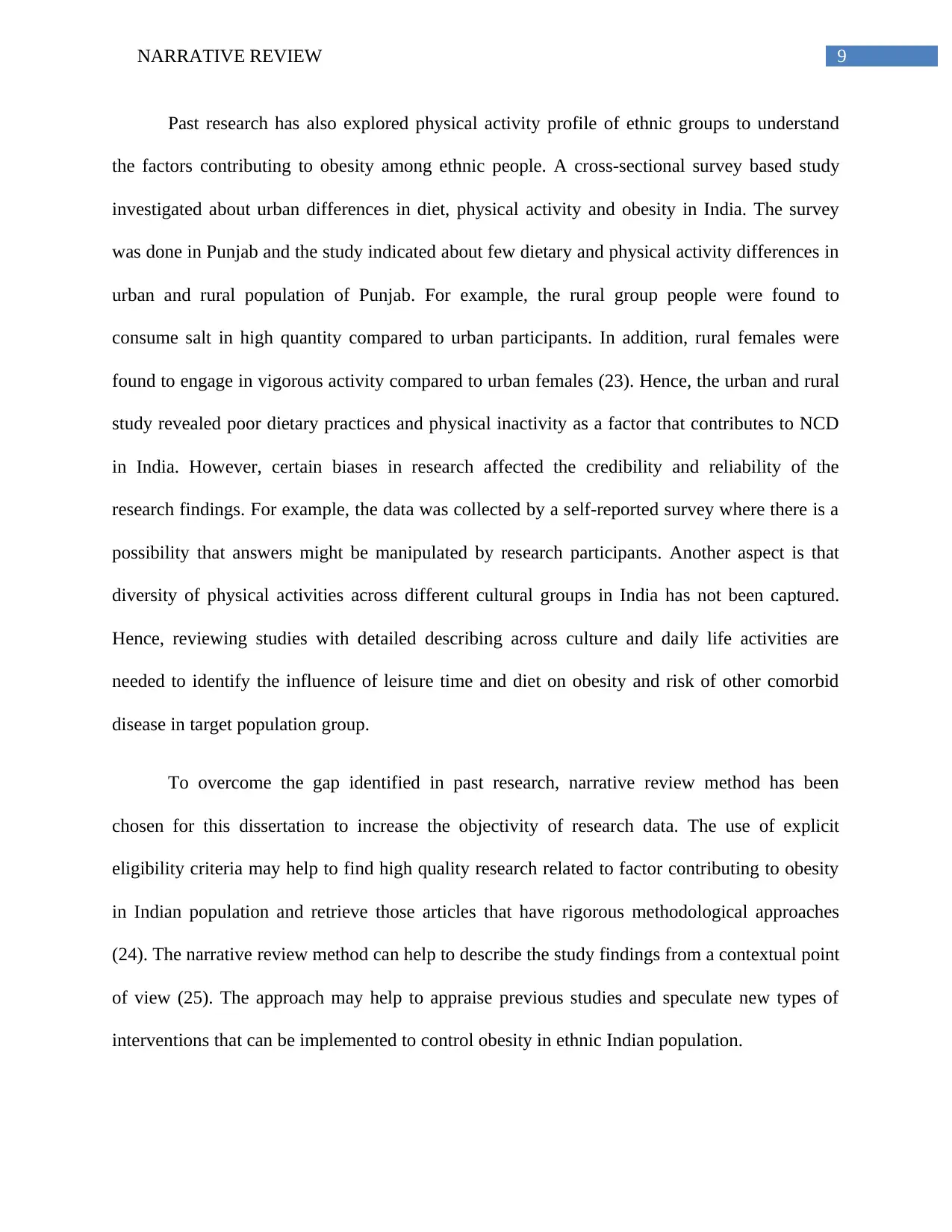
9NARRATIVE REVIEW
Past research has also explored physical activity profile of ethnic groups to understand
the factors contributing to obesity among ethnic people. A cross-sectional survey based study
investigated about urban differences in diet, physical activity and obesity in India. The survey
was done in Punjab and the study indicated about few dietary and physical activity differences in
urban and rural population of Punjab. For example, the rural group people were found to
consume salt in high quantity compared to urban participants. In addition, rural females were
found to engage in vigorous activity compared to urban females (23). Hence, the urban and rural
study revealed poor dietary practices and physical inactivity as a factor that contributes to NCD
in India. However, certain biases in research affected the credibility and reliability of the
research findings. For example, the data was collected by a self-reported survey where there is a
possibility that answers might be manipulated by research participants. Another aspect is that
diversity of physical activities across different cultural groups in India has not been captured.
Hence, reviewing studies with detailed describing across culture and daily life activities are
needed to identify the influence of leisure time and diet on obesity and risk of other comorbid
disease in target population group.
To overcome the gap identified in past research, narrative review method has been
chosen for this dissertation to increase the objectivity of research data. The use of explicit
eligibility criteria may help to find high quality research related to factor contributing to obesity
in Indian population and retrieve those articles that have rigorous methodological approaches
(24). The narrative review method can help to describe the study findings from a contextual point
of view (25). The approach may help to appraise previous studies and speculate new types of
interventions that can be implemented to control obesity in ethnic Indian population.
Past research has also explored physical activity profile of ethnic groups to understand
the factors contributing to obesity among ethnic people. A cross-sectional survey based study
investigated about urban differences in diet, physical activity and obesity in India. The survey
was done in Punjab and the study indicated about few dietary and physical activity differences in
urban and rural population of Punjab. For example, the rural group people were found to
consume salt in high quantity compared to urban participants. In addition, rural females were
found to engage in vigorous activity compared to urban females (23). Hence, the urban and rural
study revealed poor dietary practices and physical inactivity as a factor that contributes to NCD
in India. However, certain biases in research affected the credibility and reliability of the
research findings. For example, the data was collected by a self-reported survey where there is a
possibility that answers might be manipulated by research participants. Another aspect is that
diversity of physical activities across different cultural groups in India has not been captured.
Hence, reviewing studies with detailed describing across culture and daily life activities are
needed to identify the influence of leisure time and diet on obesity and risk of other comorbid
disease in target population group.
To overcome the gap identified in past research, narrative review method has been
chosen for this dissertation to increase the objectivity of research data. The use of explicit
eligibility criteria may help to find high quality research related to factor contributing to obesity
in Indian population and retrieve those articles that have rigorous methodological approaches
(24). The narrative review method can help to describe the study findings from a contextual point
of view (25). The approach may help to appraise previous studies and speculate new types of
interventions that can be implemented to control obesity in ethnic Indian population.
Paraphrase This Document
Need a fresh take? Get an instant paraphrase of this document with our AI Paraphraser
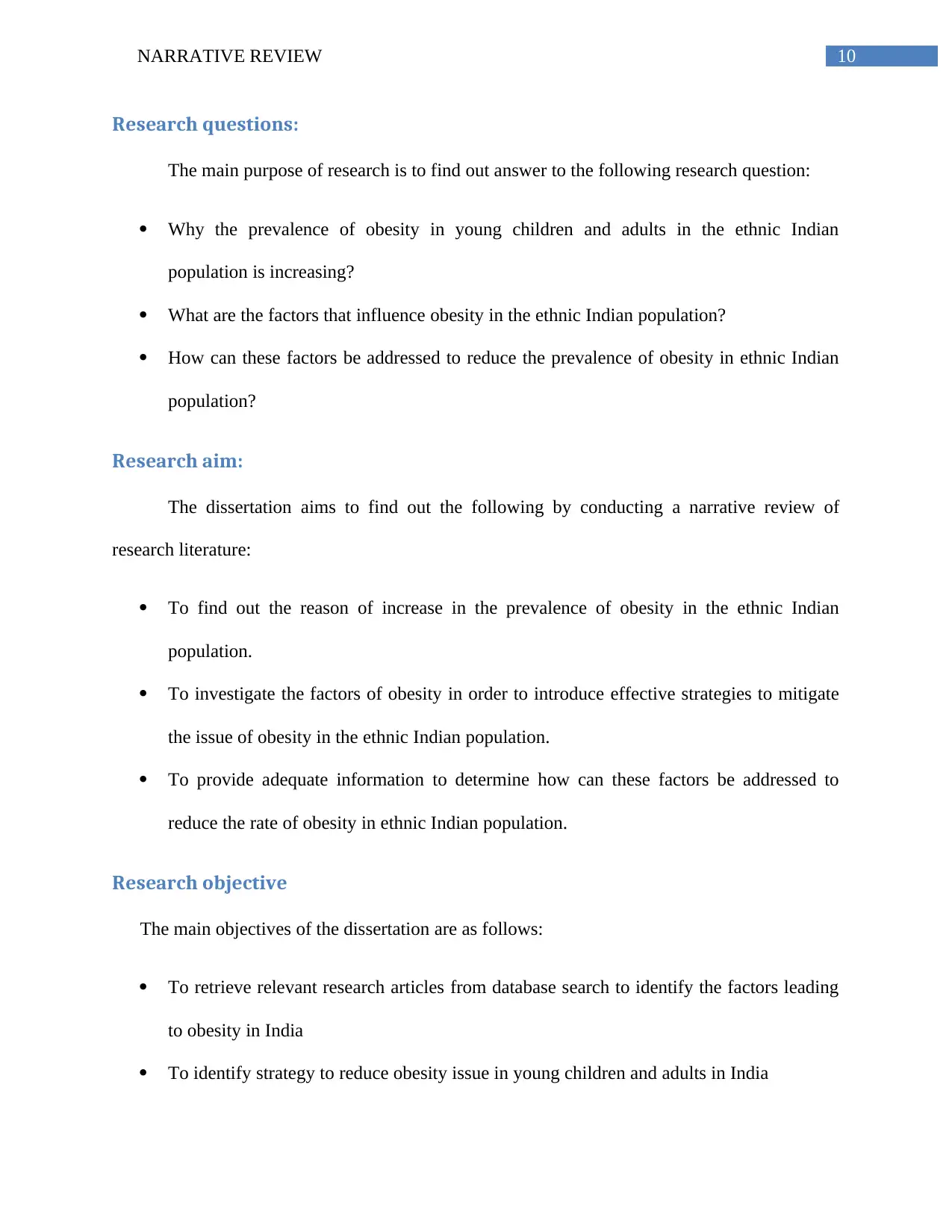
10NARRATIVE REVIEW
Research questions:
The main purpose of research is to find out answer to the following research question:
Why the prevalence of obesity in young children and adults in the ethnic Indian
population is increasing?
What are the factors that influence obesity in the ethnic Indian population?
How can these factors be addressed to reduce the prevalence of obesity in ethnic Indian
population?
Research aim:
The dissertation aims to find out the following by conducting a narrative review of
research literature:
To find out the reason of increase in the prevalence of obesity in the ethnic Indian
population.
To investigate the factors of obesity in order to introduce effective strategies to mitigate
the issue of obesity in the ethnic Indian population.
To provide adequate information to determine how can these factors be addressed to
reduce the rate of obesity in ethnic Indian population.
Research objective
The main objectives of the dissertation are as follows:
To retrieve relevant research articles from database search to identify the factors leading
to obesity in India
To identify strategy to reduce obesity issue in young children and adults in India
Research questions:
The main purpose of research is to find out answer to the following research question:
Why the prevalence of obesity in young children and adults in the ethnic Indian
population is increasing?
What are the factors that influence obesity in the ethnic Indian population?
How can these factors be addressed to reduce the prevalence of obesity in ethnic Indian
population?
Research aim:
The dissertation aims to find out the following by conducting a narrative review of
research literature:
To find out the reason of increase in the prevalence of obesity in the ethnic Indian
population.
To investigate the factors of obesity in order to introduce effective strategies to mitigate
the issue of obesity in the ethnic Indian population.
To provide adequate information to determine how can these factors be addressed to
reduce the rate of obesity in ethnic Indian population.
Research objective
The main objectives of the dissertation are as follows:
To retrieve relevant research articles from database search to identify the factors leading
to obesity in India
To identify strategy to reduce obesity issue in young children and adults in India
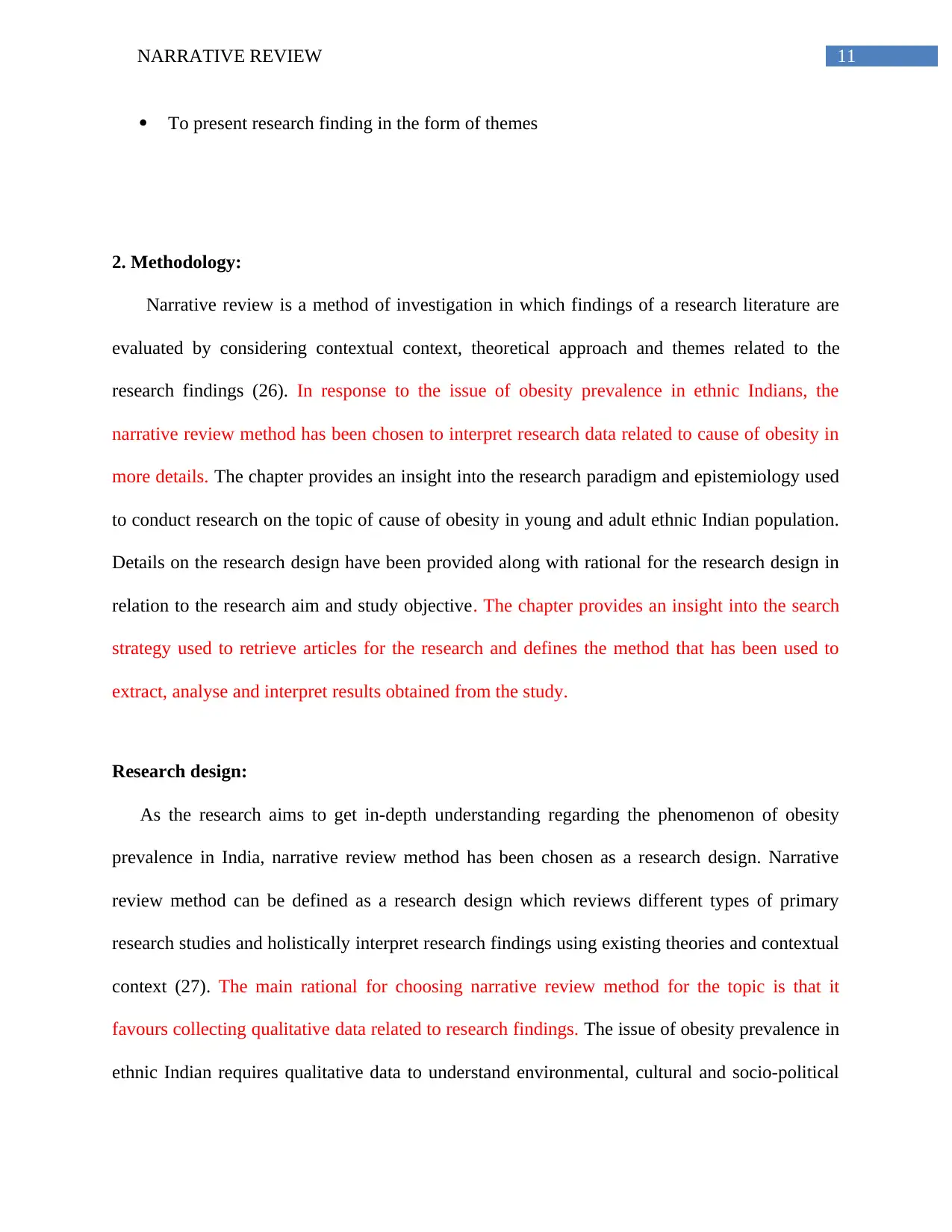
11NARRATIVE REVIEW
To present research finding in the form of themes
2. Methodology:
Narrative review is a method of investigation in which findings of a research literature are
evaluated by considering contextual context, theoretical approach and themes related to the
research findings (26). In response to the issue of obesity prevalence in ethnic Indians, the
narrative review method has been chosen to interpret research data related to cause of obesity in
more details. The chapter provides an insight into the research paradigm and epistemiology used
to conduct research on the topic of cause of obesity in young and adult ethnic Indian population.
Details on the research design have been provided along with rational for the research design in
relation to the research aim and study objective. The chapter provides an insight into the search
strategy used to retrieve articles for the research and defines the method that has been used to
extract, analyse and interpret results obtained from the study.
Research design:
As the research aims to get in-depth understanding regarding the phenomenon of obesity
prevalence in India, narrative review method has been chosen as a research design. Narrative
review method can be defined as a research design which reviews different types of primary
research studies and holistically interpret research findings using existing theories and contextual
context (27). The main rational for choosing narrative review method for the topic is that it
favours collecting qualitative data related to research findings. The issue of obesity prevalence in
ethnic Indian requires qualitative data to understand environmental, cultural and socio-political
To present research finding in the form of themes
2. Methodology:
Narrative review is a method of investigation in which findings of a research literature are
evaluated by considering contextual context, theoretical approach and themes related to the
research findings (26). In response to the issue of obesity prevalence in ethnic Indians, the
narrative review method has been chosen to interpret research data related to cause of obesity in
more details. The chapter provides an insight into the research paradigm and epistemiology used
to conduct research on the topic of cause of obesity in young and adult ethnic Indian population.
Details on the research design have been provided along with rational for the research design in
relation to the research aim and study objective. The chapter provides an insight into the search
strategy used to retrieve articles for the research and defines the method that has been used to
extract, analyse and interpret results obtained from the study.
Research design:
As the research aims to get in-depth understanding regarding the phenomenon of obesity
prevalence in India, narrative review method has been chosen as a research design. Narrative
review method can be defined as a research design which reviews different types of primary
research studies and holistically interpret research findings using existing theories and contextual
context (27). The main rational for choosing narrative review method for the topic is that it
favours collecting qualitative data related to research findings. The issue of obesity prevalence in
ethnic Indian requires qualitative data to understand environmental, cultural and socio-political
⊘ This is a preview!⊘
Do you want full access?
Subscribe today to unlock all pages.

Trusted by 1+ million students worldwide
1 out of 62
Related Documents
Your All-in-One AI-Powered Toolkit for Academic Success.
+13062052269
info@desklib.com
Available 24*7 on WhatsApp / Email
![[object Object]](/_next/static/media/star-bottom.7253800d.svg)
Unlock your academic potential
Copyright © 2020–2025 A2Z Services. All Rights Reserved. Developed and managed by ZUCOL.





